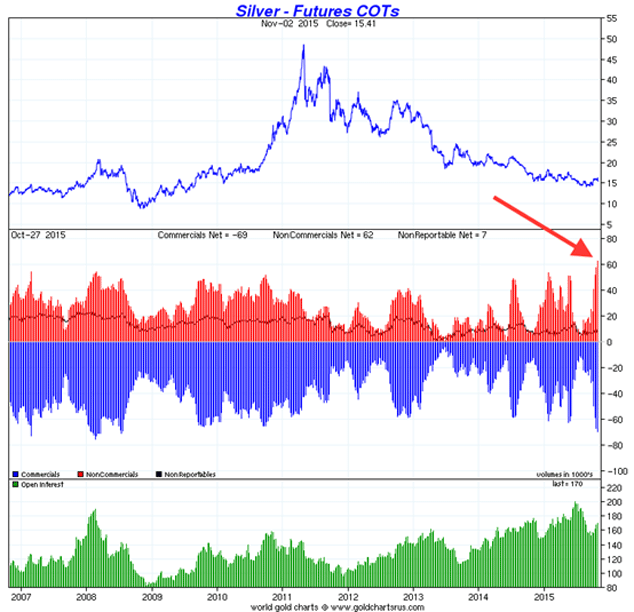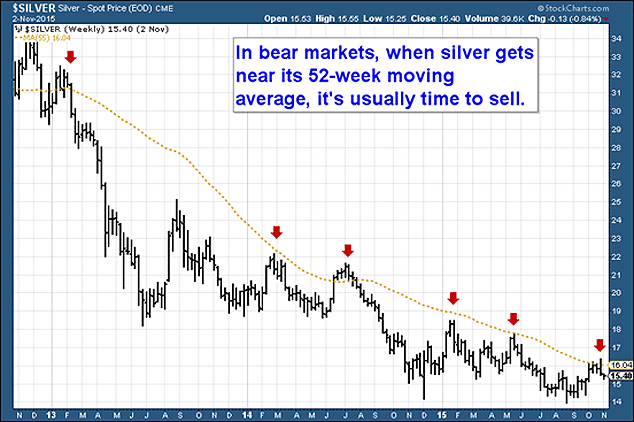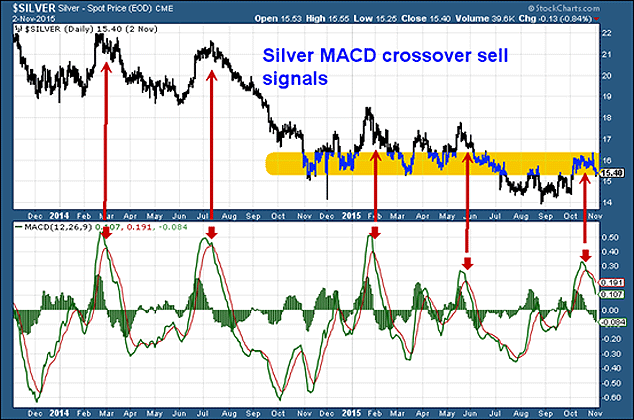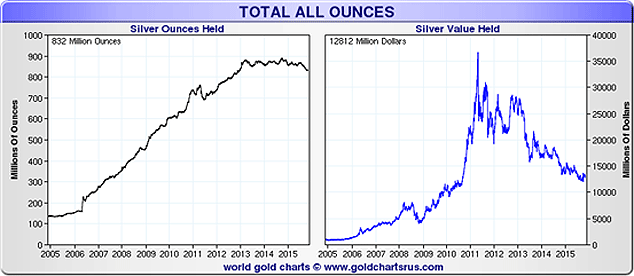With our palladium short from two weeks ago working well and nicely in the money, today we turn our attention to a similarly coloured and similarly aberrant metal – silver.
I’m short.
Today I want to explain why.
Let’s start with some disclosure. I own silver.
Not as much as some of the keenest enthusiasts I know, many of whom have bought, quite literally, a tonne of the stuff (around 35,000 oz). But a sizable stash nonetheless.
And I’ve no plans to sell it. Apart from anything else, selling physical metal is a hassle. That’s one of the reasons I like physical metal. Any sale or purchase becomes a big decision, not something you do lightly at the click of a mouse.
To be honest, I’m not sure I’ll ever get round to selling it – not unless I really need the dough.
In my trading account, however, I went short last week. Here are five reasons why:
The idiots were cheering
Different people have different measures of sentiment. Here’s one that I use – my “idiotmeter”.
I have found it to be a most instructive instrument. I read various investment chatboards both here and in North America. While some of the participants are bright, many are – hmm, what’s the word? – idiots. It doesn’t take long to identify who’s in which category.
Sure, I follow the bright guys. Often what they say is interesting and informative. But I also like to follow the idiots – those who many would choose to ignore. Their behaviour can be telling.
As silver went from below $14 an ounce in August to above $16 in October, the idiots got louder, more celebratory and more aggressive. There was my first warning.
The COT report was ultra-bearish
Moving on to what the traders on the futures exchanges are doing, we have the COT (commitments of traders) report. This shows the commitments – the positions in other words – that traders have taken.
Traders are grouped into three categories: the commercial traders, the large speculators and the small speculators. The basic wisdom is that the commercials tend to get it right – so you want to follow them.
The week’s data is released on a Friday. And last week’s showed the large speculators to be the longest – ie, the most bullish – they’ve been in nine years, with the commercial traders the most net short they’ve been.
That is not a positive development if you’re looking for price rises.
(For those that have an interest in these things, the chart below, courtesy of Nick Laird over at Sharelynx, shows the COT positions. I have drawn an arrow pointing to the current long position of the large speculators.)
Silver reached its one-year moving average
Here is a weekly chart of silver over the last three years. The dotted amber line is the 52-week (one-year) simple moving average – it shows the average price of silver over the previous 52 weeks.
That average is trending down, and the silver price has consistently failed to break above it. Once or thrice a year, silver has been able to rally up to it, only for that rally to run out of steam.
In October, silver re-tested it once again. Time to sell.
Computer says “sell”
The $15-16 range (shaded in amber on the chart below) has consistently been an area of both support and resistance for silver since as far back as the 1970s. With the silver price now sitting below it, it has become an area of considerable resistance.
It was already likely that silver would not be able to make it much above.
And just as silver was running into that resistance, we got a “MACD sell signal”. MACD is a technical measure of momentum. Look at the bottom half of the chart below.
When the green line passes down through the red line (I have marked these crossovers with red arrows) that is your ‘sell’ signal (and when the red line passes up through the green that is your buy. I have not marked the buys.)
Despite this bear market, silver is still way over-owned
Silver has fallen from $50 to $15. That’s some drop. But its investors are loyal where many might have bailed.
If you look at the amount of silver held in repositories worldwide (that includes the exchange-traded funds), the numbers have remained high since 2012, even though the value of the silver has plummeted.
Courtesy of Nick Laird once again, we see on the left the amount of silver held. And on the right, the value of that silver.
One has fallen, the other has not. I won’t be convinced that silver’s bear market is over until I see silver holdings much lower. Basically, we need to see a much greater purging before we can pronounce the bear dead.
But I’m still hanging on to my physical metal stash
It was not one of these indicators alone that told me to sell, but the fact that we got a cluster of them together – excessive bullish sentiment among the incognoscenti, that huge long position from the large speculators on the Comex, the one-year moving average, the historical pivotal price point around $16, the MACD sell and, finally, the fact that silver remains so over-owned.
So that’s why I sold.
But I didn’t sell my physical. As I said, I doubt I’ll ever get round to selling that. I guess I’ll leave it to my kids with strict instructions to flog it when silver next goes to $50, as it seems to do once a generation.
Instead, I took the less hasslesome road. I went short in my trading account.
My first target is $15, though $14.50 is calling…
Category: Market updates





